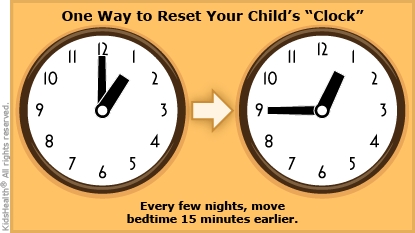Delayed Sleep-Wake Phase Disorder (DSWPD): How to Care for Your Teen
Everyone has an internal "clock" that tells their body when to sleep and when to wake up. This is called a circadian rhythm. During the teen years, this "clock" shifts to later hours, telling teens to fall asleep later and wake up later than younger kids or adults. This isn't usually a problem if they wake up easily and function well during the day. But for teens who have DSWPD, the shift makes it hard for them to fall asleep at the time that they want to or need to. They end up falling asleep very late and have trouble waking up early for school or other activities. They also find it hard to function during the day.


Managing DSWPD involves resetting the body's internal "clock" so that bedtime can shift to an earlier time that works for social and academic schedules. This includes changing sleep and wake times, having a bedtime routine, and avoiding things that can make it hard to fall asleep. It can help for your teen to:
-
Avoid caffeine, tobacco, and other stimulants.
-
Turn off bright lights and televisions, computers, and video games at least an hour before bed.
-
Keep their bedroom dark and quiet while sleeping.
-
Create a relaxing bedtime routine. It can include a light snack, a bath, and quiet activities like reading.
-
Avoid napping and sleeping late on weekends because this can make DSWPD worse.
-
Reset their "clock" by:
-
Going to bed a bit earlier. Every few nights, they can go to bed 15 minutes earlier. If they usually fall asleep at midnight, they can set bedtime at 11:45 p.m. for a few nights, then 11:30 p.m., and so on.OR
-
Going to bed 2 or 3 hours later each night. If they usually fall asleep at 2 a.m., move bedtime to 4 a.m. one night, 6 a.m. the next day, 9 a.m. the next day, and so on until the right bedtime is reached. Allow your teen to wake up without an alarm clock. It usually takes about a week to change the bedtime, so it's easier to do this during a school vacation.
Other things to know:
-
After your teen has set a new bedtime, they should go to bed at the same time every night, including on weekends. DSWPD can return after just one night of staying up late.
-
Your teen shouldn't take melatonin or other sleep aids unless their health care provider recommends it.
-
The health care provider might suggest having your teen sit in front of a sunny window or light box every morning to help the body's clock go back to normal.
-
If the health care provider suggested keeping a sleep log, your teen should write down sleep and wake times as well as feelings of sleepiness or wakefulness.


What is the difference between being a "night owl" and having DSWPD? "Night owls" like to stay up late, but they usually can wake up on time for school and work and don't have trouble functioning properly during the day. People with DSWPD have a very hard time getting up in the morning and feel sleepy during the day, which can make it hard for them to pay attention in school, stay organized, and make good decisions. Sometimes it can even be linked to depression.
How is DSWPD diagnosed? It's considered DSWPD when, for at least 3 months, a person has trouble falling asleep at the time that they want to or need to (usually it takes them more than 2 hours to fall asleep). They also have a hard time waking up when they want to or need to. If allowed to sleep in, they will sleep for the number of hours they need and wake up feeling refreshed. DSWPD often starts in the teen years and usually gets better in adulthood.